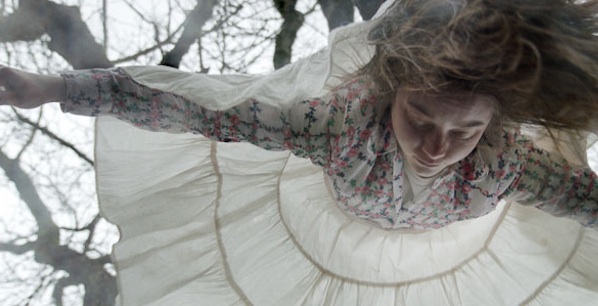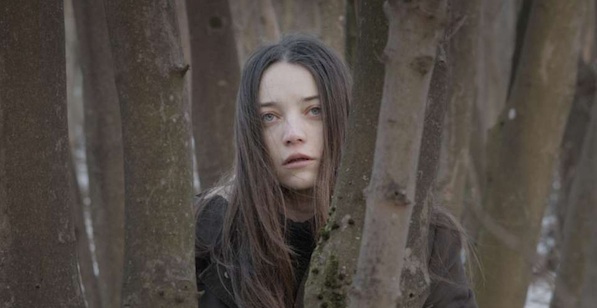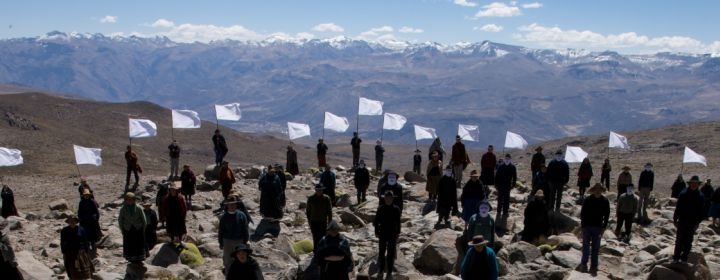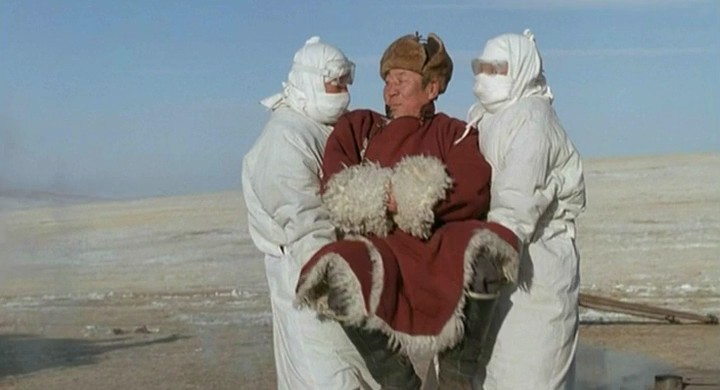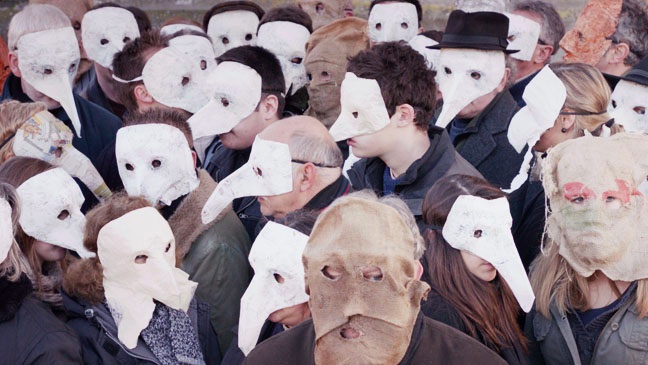The Fifth Season by Peter Brosens and Jessica Woodworth, playing recently in Poland’s New Horizons and set in a small farming village, follows the lives of its inhabitants, who, as a result of a mysterious plague of famine engulfing the area, undergo a slow, terrifying transformation. No, they don’t grow claws or vampire teeth and turn into werewolves. What slowly deteriorates is the town’s psyche. A rustic, friendly village slowly turns into an oasis of paranoia, hatred and indifference. Mutual trust disappears leaving fertile ground for rapidly growing hostility. Herd instinct and the unstoppable drive to find a scapegoat result in ostracism of the only newcomer in the area. It’s a film about the modern witch-hunt, a lot more focused, however, on the processes that lead to such a situation than on the inescapable finale itself.
Brosens and Woodworth managed to create a film with a sense of mystery, one that poses a lot of uncomfortable questions and leaves an ashen aftertaste in the viewers’ mouths. Despite the opportunities offered by the script, at no time do the filmmakers lean toward horror or thriller. This is a subtle and piercing story about the collapse of civilization and those primal instincts that we persistently displace on daily basis, only to have them resurface under duress. Visually, The Fifth Season combines the tradition of Flemish painting with a fairy-tale-like imagination stigmatized by Grimm-ish cruelty and bitterness. Murmuring boughs of trees leaning to fall. Faces pale as parchment. The piercing gaze of the camera, when an owl suddenly lands in front of it. Flies suffocating in a dirty glass of wine. The Fifth Season is story of a community that is rotting and falling apart right in front of our eyes, shot by highly sensitive artists who understand the unique relationship of beauty, pain and absurdity.
Keyframe: The Fifth Season is one of those films that the viewer simply feels; its emotional impact is very intense and holistic. Was giving it such power intentional?
Peter Brosens: The story is very important in every film, but more important is how you tell it. And cinema is so rich, it has so many possibilities to create something that transcends the normal emotional impact of the plot, to go beyond it. It can be an invitation to reach some states of mind. It’s the same thing that music does, or painting—art in general. And that is very important for us. The cinema can have a direct impact, just like music does. Music is probably the most direct medium there is; there’s nothing in between, it goes directly to your soul. It’s scary.
Jessica Woodworth: What’s primordial for us is the sound. As we’re creating the concepts for images, there’s always this parallel process. We’re always saying that the ear is more creative than the eye.
Brosens: Yes, because the eye registers what’s on the surface whereas the ear has much larger power of imagination and that’s often neglected in cinema. In film, or, to be exact, more commercial films, music is used to reinforce emotions that are already present in a narrative and dramaturgy. But I think sounds allow you to create a whole other dimension in the dialogue between the soundtrack and the images.
Keyframe: …but it’s also very beautiful. What you’re saying you wanted to achieve, you did. It’s not happening too often these days in film, to be honest.
Woodworth and Brosens: [Laughing.] Thank you. We’re very touched.
Keyframe: Your cinematographer, Hans Bruch, Jr., was also responsible for the amazing Blue Bird by Gust Van Den Berghe. There’s a similar sensitivity in your film as well. His style is maintained, yet this film is evidently yours. We’ve already talked sound design; how does it come together image-wise for you?
Brosens: We’ve done three different films with three different cinematographers.
Woodworth: But they all have the same signature. In this particular case the shooting and building of the vision and sound were actually, due to circumstances, quite separate.
Brosens: Normally we don’t work this way.
Woodworth: No. Here it was only in the editing room that we started collaborating. The universe of the shooting was separate and isolated. A thirty-one-day period where we were just struggling to stay in budget and survive. [Laughs]….I would say that there wasn’t harmony in the shooting process, only later, in this case.
Brosens: With other films there was really a dialogue in the creation of the sound and, of course the image, because their synergy is so important.
Woodworth: It was not our wish. Unluckily, things like that do happen. Yet, it still worked out, or so it seems. [Laughs].
Keyframe: Was this vision easy to accomplish? Did you know how the film was going to turn out from the very beginning, or was it rather a process in the making?
Woodworth: In The Fifth Season it was an ongoing process of discovery. The palette was not entirely sure ’til the very end, because it’s digital cinema, so the possibilities are immense. The colors contribute to this eerie, haunting atmosphere, and we were discovering as we were shooting how we were going to sculpt with time, which contributes also to how you perceive the story, how you live it. This atmosphere, the silence, we thought… originally, when we were writing the fundraising files, we talked about silence a lot, without understanding what kind of silence we were going to be building. But the silence is actually full of sounds, and we discovered that with our composer, Michel Chopin, along the way. This tsunami of silence coming in fact contains a whole zoo of elements that are throbbing and humming and buzzing, almost out of perception, almost beyond our perception, but it’s there, it’s there… It’s an immense sound design.
Keyframe: Not only sound design, also visuals, that we mentioned before. And acting. It is such a synesthetic production.
Brosens: This was the exact purpose of all our three films.
Woodworth: We hoped, we hoped… But there’s a resistance, a constant struggle, because a script has two dimensions and you have to convince the funding bodies that you have a story, that it’s impossible to reduce so much of The Fifth Season into words on paper. It took years to build that budget because of the deficiency of the script. But we were convinced that all the unspoken and everything that resides in between actions and underneath the surface we could bring alive. But we couldn’t express it adequately in the script so it was a struggle.
Keyframe: I think I understand what you mean. I had the same ‘problem’ with your film. When writing about it I felt like I probably should say what it’s about, but I didn’t want to, I preferred to say what it feels like…
Woodworth: That’s funny because that’s exactly the one question we’re always trying to avoid: ‘What it’s about?’ The same thing happened with Khadak and Altiplano because it’s so subjective and so private what these films are about. They are rooted in actual conflicts between indigenous groups and the corporate world essentially. We were confined to respecting actual conflicts that are unfolding in Asia or South America. The Fifth Season was liberating in this sense that it’s more ambiguous. We were freer.
Brosens: It’s also like a final part of a trilogy. Khadak was set in Mongolia, in Mongolian steppe, Altiplano in the high Andes, in Peru. These two stories really focus nature and how fragile cultures, who are very dependent on it for their lives and survival, are constantly violated. In The Fifth Season we decided to situate the story in a village where we live. And there’s reversal: here, the main protagonist is nature, which is protesting against mankind. It could be a sort of a consequence of the first two films, but also it’s real. Look, what’s happening to our planet. We are in bad shape and hopefully this film can encourage people to reflect on the essential things that are going on.
Keyframe: Indeed, there’s an overwhelming sense of sadness, and of loss, woven into this narrative, that, to me, was very difficult to confront. But at the same time, there’s no better way to make people think, that to make them feel…
Woodworth: Yes. It’s the cinema of sensation. We’re not concerned what people learn about the extinction of bees or an ecological imbalance, but what they feel—not only consciously, buy also subconsciously. Things that might surface later, echoes that remain bouncing around as you carry the memory of the film forward. We’re not that into the story, the denouement of the story, how the films conclude. Actually, none of the three conclude at all. We were asked already a few times about ‘the message’ of the film’—and how dare we give a message, we don’t have it! It’s sad… it’s not a didactic production.
Keyframe: To me ‘the message’ is something that the audience should be able to start constructing themselves when confronting the film…
Brosens: Exactly!
Woodworth: And it would be anyway subjective…
Keyframe: ..and a different answer.
Woodworth: … from each person.
Brosens: I think this film is an opposite of the ‘message film’ idea. If it was one, we’d be the senders and you the receiver. Whereas for us, I hope it is, the film is more like an invitation. We offer you a place to maybe wander and ponder for a while. It might leave an impression and make you think of something beyond what the message is, really. It’s so intimate.
Keyframe: Messages are boring and close-minded!
Woodworth: [Laughs.] And also, what would it be? What could be the message of The Fifth Season? It could be a thousand things!
Keyframe: In a way, every message you’d try to put in the film would be offensive for your work because it would be a reduction. Also, if you’re not a ‘message’-type of a director, you give yourself a chance of staying interested in the story and the characters instead of just illustrating your assumptions.
Brosens: To me, personally, the most important scenes in the film are the scenes after the burning of Paul. Until then we’re sort of attached to the classical narrative structure but from there onwards… Still, you have to reach that, earn that as well as a filmmaker. The last ten minutes to me is what cinema is about. It’s also the case of Khadak and Altiplano, that have similarly structured endings.
Woodworth: We always had the idea of what the end would be. We just didn’t know if we’d achieve that. And we still don’t know if we did. We’ll see in time how many people reached the state of mind we were trying to evoke. But the last stretch of The Fifth Season, and the first two as well, were trying to be what one of our viewers called it: an earthquake. Or a bomb.
Brosens: It’s great, it’s like a book: there are ten different readers and we get ten different books. With this film, some people say….
Woodworth: ‘…This is nonsense!’ [Laughs.]
Brosens: But we are ready for that.
Woodworth: We’re used to this, we’ve already been there.
Brosebs: One of really fantastic compliments we received was from someone from France who saw the film and wrote that for her it evokes ‘the dawn of the new humanity.’ It’s incredible that that can be a reaction or an interpretation of a viewer after watching this film.
Keyframe: It actually makes a lot of sense, because, in a way, your film is a story—if I can call it such—that’s descending towards an inevitable closure. But because it’s also about nature, it naturally evokes thoughts of something cyclical, of a come-back, of something being there after death.
Woodworth: Something comes from the ashes, something will come. And the boy’s disappearance could be so many things… it’s a chance. That’s what we wanted. Our colleagues, producers nagged us about lack of hope in this project: ‘Hope! Hope! The audience wants hope!’ they’d say. But hope can be found in most unexpected places!
Brosens: To be so blunt would be disrespectful to the viewer.
Woodworth: I think the industry underestimates the viewer. We’ve witnessed this for years. They underestimated the capacity of the eighteen-year-olds to interpret off the cuff, eloquently, beautifully, honestly. With The Fifth Season some professionals were like [speaks in a funny voice]: ‘I hope they’ll understand, I don’t get it why they don’t get to the point’… Get to the point? Then they’ve missed the point completely!
Keyframe: That, to me, is the curse of the ever-present story domination that we talked about.
Woodworth: The story that’s built on action and words that come out of the actors’ mouth. Those are the building blocks. But so much we’re interested in is underneath. We can’t reduce a character in a film to some dialogue and some action. That’s why we don’t rehearse. Many of our collaborators are not professional actors, they’re young, it’s their first film… we don’t want to lose their truth in rigid rehearsals. At any one point in time one is filled with a whole complex of emotions, form which only tiny bit is visible, or discernible. We want to honor that.

